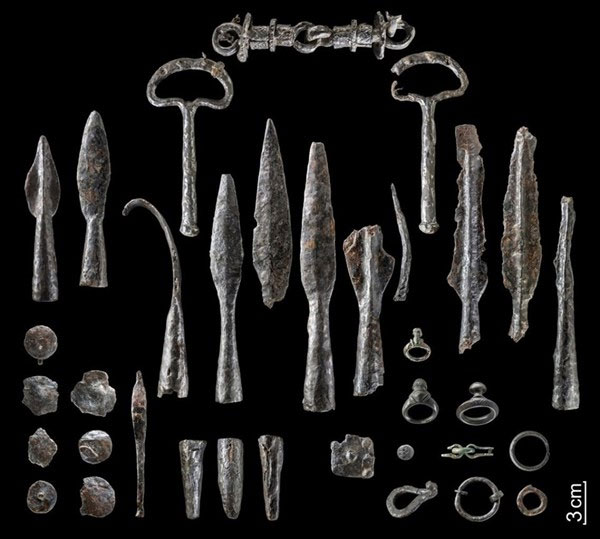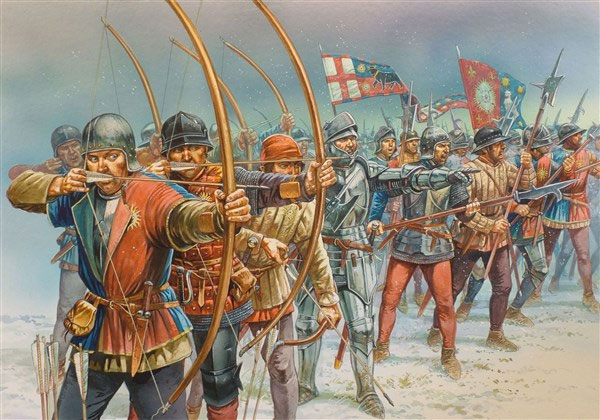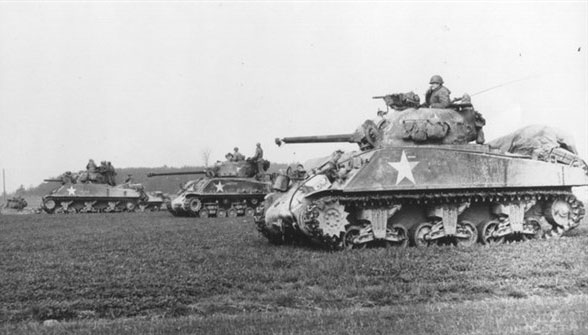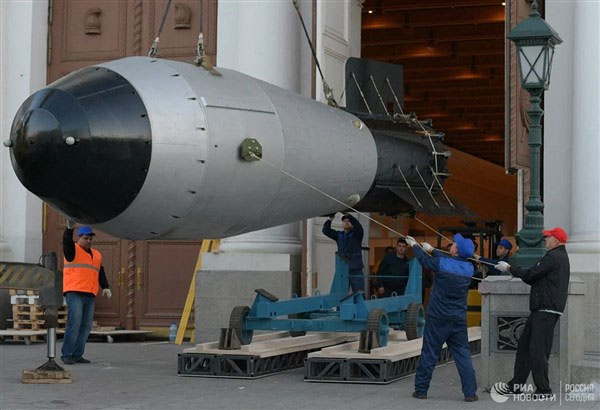Originally developed for hunting and combat against dangerous creatures, weapons have evolved and improved throughout history. The Fourth Industrial Revolution has significantly accelerated advancements in weaponry.
Early Period
Since ancient times, weapons have served as tools to protect humans from the lurking threats of animals and fellow humans. Cave paintings depict scenes of Stone Age men fighting with primitive weapons such as sticks, axes, and spears.

Spearheads and bows from before the Common Era are simulated.
Developing from a wooden stick cut from the strongest trees in the jungle, many tribes across Africa and the Pacific transitioned to forging axes from wood and stone. In Australia, indigenous people crafted large boomerangs from wood to combat enemies. However, the drawback of these weapons was their tendency to get lost and their relatively low lethality.
The Sumerians, who lived in present-day Iraq, were the first to use copper weapons. In battles, Sumerian soldiers employed bows and arrows, fighting with spears, axes, and clubs. They innovated by creating leather jackets reinforced with copper and wearing helmets made of bronze, carrying rectangular shields for protection in combat.
From 850 to 800 BCE, the Assyrians, who inhabited the region now known as Iraq, established a great empire in the Middle East. Assyrian soldiers improved siege engines into mobile siege machines, utilizing new techniques to forge iron into steel suitable for weaponry.
Notably, soldiers combined chariots, cavalry, and infantry in their legions. Each chariot carried a combat team of three: a driver, an archer, and a shield-bearer. Cavalry fought with bows and arrows, while infantry used bows, spears, swords, and crossbows. The Assyrians also equipped their soldiers with sturdy boots for long marches.
By 400 BCE, the Spartans in Greece had learned to make sulfur blocks to use against enemies. More than a century later, the Macedonians invented the catapult, which was considered an extremely useful tool for attacking the most fortified strongholds. The catapult operated on a propulsion mechanism, helping soldiers launch large, hard stones at enemy fortifications.
As the pre-Common Era period closed, in 250 BCE, the Chinese invented the crossbow. This invention revolutionized warfare, and the technology spread from Asia through the Middle East to Medieval Europe.
Thanks to the crossbow, archers did not require much strength or skill to shoot arrows. Furthermore, the compact size of the crossbow allowed for the firing of 10 to 15 arrows at once, conserving energy while achieving higher combat effectiveness compared to traditional bows.
Numerous Innovations Emerged

Illustration of a longbow invented by the British army.
Entering the Common Era, humans began to organize combat formations to conserve energy and create significant impact on the battlefield. Leading this progress were the Saxons.
The Saxon strategy typically involved forming a “shield wall” by arranging soldiers side by side, spreading their shields out in a line. This tactical shield wall was highly effective. Notably, Saxon soldiers from the upper class were also equipped with chain mail.
Following the Saxons, the Vikings spread terror across Europe. They also fought with spears, axes, and swords, employing the “shield wall” tactic. Additionally, they dug moats and built earthworks with wooden palisades on top to protect their inner fortifications.
However, by the 14th century, warfare was transformed by the longbow, invented by England in 1298. In reality, the longbow was not a new weapon, as it had been used since before the Common Era. However, the English utilized it in an entirely new way.
In the early Middle Ages, archers would attack to “soften” the enemy before infantry charged into battle. However, the English employed a new tactic by dismounting cavalry to protect the archers and allowing the enemy to charge forward. This way, the opposing cavalry was quickly devastated by the archers.
The longbow helped the English army achieve decisive victories on historically renowned battlefields such as Crécy (1346), Poitiers (1356), and Agincourt (1415). An archer could fire arrows every 5 to 6 seconds, reaching distances over 200 meters. The drawback of this weapon was that soldiers required many years to learn to use it properly.
During this time, the Mongol Empire utilized cannons in the Battle of Ain Jalut against the Mamluk Sultanate. Cannons were developed during the Song Dynasty in China. Initially, they were a method of using gunpowder but were improved into handheld firearms. They could achieve dual purposes: against infantry and for besieging fortifications.
Shortly after the invention of cannons, Europeans adapted them into handguns. Initially, these guns were activated by match ignition. Soldiers would use matches to ignite a fuse leading to the gunpowder compartment. Each soldier typically carried 2 to 3 guns and a sword to be ready for combat in any situation. Gradually, the longbow of the English was no longer in use.
To enhance firearms, in 1688, French military engineer Sebastian de Vauban invented the bayonet, resembling a smaller spear, attached to firearms. With this weapon, soldiers could stab enemies at any time.
By 1846, Houiller, a gunsmith in Paris, invented the metal bullet, heralding a new revolution in weaponry. Subsequently, a series of firearms were invented, such as rifles, machine guns, and torpedoes, with destructive capabilities and astonishing firing rates.
In the early 19th century, British inventor William Congreve developed the Congreve rocket, used on the battlefield in Copenhagen in 1807. However, the rocket lacked range and accuracy, leading to its decline in popularity after the Napoleonic Wars.
During this period, biological weapons were also employed. Specifically, taking advantage of the plague pandemic, the Mongol Empire used catapults to throw the bodies of plague victims over enemy walls to spread the disease.
Weapon Manufacturing “Leaps Forward”

Tanks used by the German army during World War I.
When World War I broke out in 1914, infantry could not advance due to the strength of the weapons at that time. As a result, in 1915, the German army devised the use of gas, chemical weapons, on the Western Front. They employed chlorine gas and gas masks. Simultaneously, they used mines to destroy enemy trenches.
Chemical weapons were relatively commonly used at the beginning of World War I. By 1907, the Hague Convention was established, prohibiting warring nations from using chemical weapons. However, the United States did not participate.
Meanwhile, in 1913, the British army unveiled the Vickers E.F 8.1, the world’s first military aircraft. Two years later, Britain continued to research and develop tanks. Aircraft were used for reconnaissance and later to drop bombs on cities, destroying the industrial achievements of the enemy.

Tsar Bomba, a type of nuclear bomb with great destructive power.
In World War II, the history of weapons experienced a leap forward as humanity discovered nuclear energy. Research on energy weapons developed rapidly and dangerously, leading physicist Albert Einstein to write a letter to U.S. President Roosevelt in 1939 warning of the dangers of nuclear bombs.
On July 16, 1945, the United States successfully tested the atomic bomb for the first time at Trinity, in the Alamogordo Air Force Base. On August 6, 1945, the U.S. dropped an atomic bomb on Hiroshima, Japan.
Just two days later, another atomic bomb exploded in Nagasaki. Each explosion killed hundreds of thousands of people, demonstrating the tremendous and horrific destructive power of this weapon.
Not stopping there, in 1951, the U.S. successfully tested the first hydrogen bomb on the Marshall Islands. Also known as the thermonuclear bomb, the hydrogen bomb is a second-generation nuclear weapon, producing explosive power thousands of times greater than the nuclear weapons used in World War II.
When this weapon is activated, the thermal radiation from the nuclear explosion heats and compresses the warhead containing materials such as deuterium and tritium, leading to a thermonuclear reaction.
By 1957, the Soviet Union announced the successful testing of intercontinental ballistic missiles. At this time, countries around the world were engaged in an arms race, focusing on research into nuclear energy. It wasn’t until 1963 that the United States, the Soviet Union, and the United Kingdom signed the Nuclear Test Ban Treaty, which helped to halt nuclear weapon tests in the atmosphere, on land, and underwater.
As we entered the 21st century, the age of technology and digital advancements, weapons were designed to minimize human casualties while still maintaining high offensive capabilities. This marked the emergence of new concepts in weaponry such as unmanned weapons and robotic weaponry.
Developed nations like the United States, Russia, and the United Kingdom have invented unmanned devices such as drones and submarines; built aircraft carriers; and developed high-energy lasers, sniper rounds, stealth armor, and infrared tracking satellite systems.
These high-tech weapons are transforming the landscape of future warfare. In this new paradigm, humans maintain autonomy, controlling technical devices and technologies through machine learning. However, high-tech weaponry simultaneously raises ethical questions and concerns about human control.
Currently, humans can master and control robots and machine learning, but the world is concerned about whether one day this technology could surpass human control.


















































